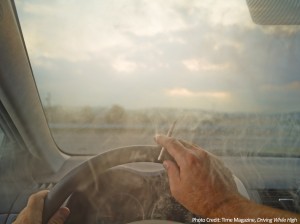So let’s be honest, marijuana, alcohol and driving just don’t mix. According to a recent TIME’S magazine article Driving While High, Dr. Marilyn Huestis, a lead marijuana researcher at the National Institute on Drug Abuse, noted the side effects of driving while high:
- Slower decisions: Pot impairs your function and problem-solving abilities, which makes it harder for drivers to make a smart choices quickly.
- Hallucinations: Research is sparse, but Huestis says pot-related cases can happen and are an “underappreciated” threat on the road.
- Reduced awareness: Brain imaging shows that it’s harder for people who are high to focus on several things at once, such as changing stoplight, and approaching bicycleand a car signaling a turn.
- Limited vision: “It’s harder to see events in your periphery.” says Huestis, referring to the tunnel-vision effect of pot, which impairs drivers’ ability to recognize obstacles to their far left and right.
- Sluggish reflexes: Pot can negatively affect the parts of the brain that coordinate and initiate movement, which makes it tougher to physically control a car.
While most of the symptoms described by Dr. Huestis overlap with symptoms of drunk driving, it would be crazy to imagine that many marijuana users still choose to drive high. In fact, most people don’t realize is that getting high behind the wheel will land you a DUI arrest.
While there isn’t really any new technology (similar to that of a breathalyzer) used right now, more and more officers are being trained to be Drug-Recognition Experts (DREs). These highly trained officers can recognize and pinpoint alcohol and drug impaired drivers and use a series of tests to recognize a driver that is under the influence of drugs, including marijuana. An article from the Seattle Times states, “Different agencies’ policies vary on when a DRE is needed, but they’re always called to investigate major collisions, especially those involving fatalities, and any in which officers suspect drug involvement beyond alcohol.”
http://seattletimes.com/html/localnews/2021561671_drugrecognitionxml.html